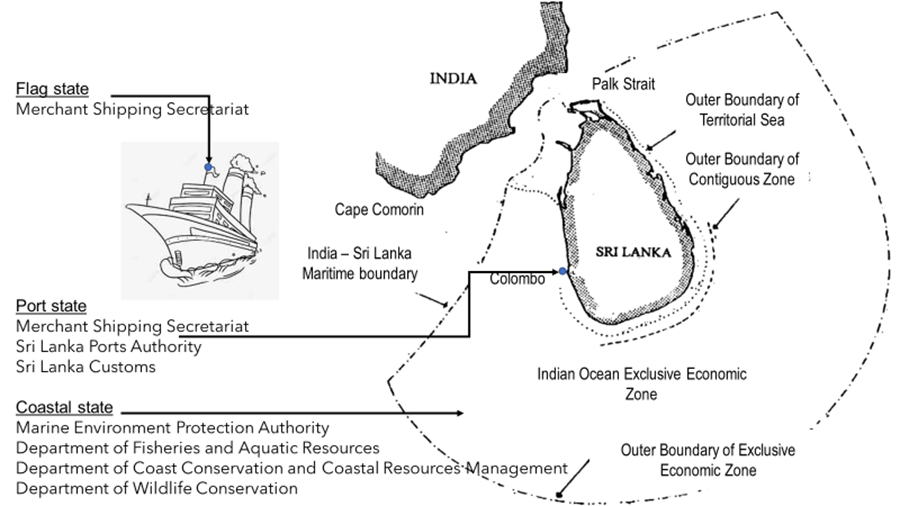Plastic Spills by Maritime Disasters: Silent Killer in Our Oceans
BY Eng (Dr.) Sameera Samarasekara
Plastic spills caused by maritime accidents exacerbate catastrophic effects on a country's environment, economy and population. The sinking of the X-Press Pearl in May 2021 is one such recent event that caused the largest plastic spill in history. Billions of these plastic and unburnt nurdles caused a continuum of plastic pollution. This incident highlighted the importance to understand and combat the impacts of this and future spills.
In terms of recent maritime accidents, the X-Press Pearl accident is a notorious and serious environmental disaster caused in Sri Lankan coastal waters in 2021. At the time of the catastrophe, the ship was carrying 1486 containers with a cargo of 25 tonnes of nitric acid, various chemicals, and low-density polyethene pellets (LDPE). The marine environment was contaminated due to the addition of Nitric acid and other chemicals as well as the LDPE pellets which are known as nurdles. The hazardous nature of pellets cannot be ignored though they are not classified as hazardous materials. Multiple detections of dead turtles, whales and dolphins washed up along the coastline of North-Western, Western and Southern Sri Lanka which is suspected as a result of the environmental damage caused by the X-Press Pearl accident. But it was not the first event. Plastic pellets accounting for over 10 tonnes of weight, were lost into the Sea from the container ship MV Trans Carrier when a container broke open due to being moved as it was sailing through rough seas at the German bight on February 2020. There were 26 tonnes of polypropylene pellets were included in the cargo in its voyage from Rotterdam, Netherlands to Tananger, Norway. Even though the incident was reported, no action was taken by the Norwegian Coastal Administration stating that the spill was too small to be concerned. Large quantities of plastic pellets have been reported to be washed up on the shores of Sweden, Denmark and Norway since Mid-March. A few other incidents to be mentioned are, the Hong Kong plastic Nurdle Spill in 2012, the Cosco Yokohama fly swatter spill in 2012 where 29 containers fell overboard due to the dangerous weather in the Gulf of Alaska. The Atlantic Lego Spill-Tokyo Express in1997, the mid-pacific rubber duck spill in1992, and the Nike sneaker spill in 1990 were all examples of plastic spills resulting from maritime accidents. Figure 1 shows the chronology of recent maritime plastic spills including the above-mentioned incidents. It starts with the shoe spill in the north pacific in 1990 and ends with the X-Press Perl incident in Sri Lanka.

Figure 1: The chronology of recent maritime plastic spills
Over 70 % of global trade by economic value is carried through maritime transport and thus it has a high economic worth. Maritime transportation has long been considered a complex activity, and the associated risk has impacts on human lives, the economy, the marine environment, and marine life. Transport and handling of hazardous plastic cargo through shipping have considerably increased over the recent decades owing to the rapid industrial development and thus snowballing the risk of heavy marine environmental pollution during marine accidents. Characteristically, maritime accidents are caused by the failure of one or more mechanisms that are required to function accurately for the successful operation of a ship. The most common marine accident type is grounding and it is only second to collisions. Over the years, a huge effort has been made to investigate the root causes of maritime accidents and eliminate them to improve maritime safety.
There are lots of causes for maritime accidents. Many of them are unavoidable like severe or extreme weather conditions. Long hours, lack of sleep leading to fatigue, inexperience, and lack of training, long voyages, extended time at sea, personal relationships aboard the vessel, reckless behaviour, including abuse of drugs and alcohol, poor decision making and/or negligence, pressures and stress of job duties are some causes of human errors that have led to maritime accidents, The so-called “Fourth Industrial Revolution”, also termed “Industry 4.0” minimize issues due to human errors with autonomous ships such as Yara Birkeland and the Autonomous Spaceport Drone Ship (ASDS)
Considerable uncertainty regarding the nature of plastic spills is pressure on mitigation of plastic spills. Microplastic distribution and pathways were also demonstrated using numerical models. Some of these models include the effects of currents, waves, and wind along with a series of processes that influence how particles interact with ocean currents, with fragmentation and degradation. Availability of archived wave, current, bathymetry, sediment, and biota data are key factors to successful mathematical/numerical modelling. Even though some sophisticated models are available, the lack of essential baseline data cases and considerable uncertainty affects to accurately forecast dispersion (and spread) of chemical spills. The focus of marine accident mitigation shifted from marine architecture to human and social factors with the development of developments in AI and computational power. There is an increasing emphasis on mathematical modelling of spills, safety enhancement of ships and ship operations while sustainability and economic perspectives are somehow neglected in the research.
The impacts of plastic spills are difficult to be evaluated with precision given the limitations in available data. A wide range of human health impacts was observed in many incidents. The remains from X-Press Pearl posed health risks, with allergic reactions including skin conditions, breathing difficulties and other long-term health concerns as well because of the content of the chemicals aboard the vessel. Some plastics that are washed into the ocean don't decay and stay there for years. Plastic spills could break the food chains in some environments and could destroy an ecosystem. Plastic damages species of bacteria that produce the oxygen sea creatures breathe. As a result of this, the oxygen content of the water decreases and marine life such as whales, turtles, and sharks do not get the necessary oxygen to breathe. Improper exposure to sunlight due to substances such as plastic floating on the ocean can distract photosynthesis and thus destroy corals and associated organisms; increasing the sea acidity also causes coral reef destruction. It can also make the regulation of temperature hard, leading to the death of aquatic life. The plastic nurdles and polythene on the gills of fish and the feathers of marine birds, make it difficult for them to navigate and disrupt the feeding of young. The plastic can go between 500 to 1000 years to decompose and is possible to be carried by ocean currents to coasts hundreds of kilometres away from the shipwreck. All these cases show that the compensation cannot satisfy all stakeholders and the right pay is still matters. However, compensation is a factor especially to enhance the livelihoods of victims. Sri Lankan government received 3.54 million USD compensation and Sri Lanka claimed 40 million USD for the X Press Pearl disaster. Availability of laws is another essential component of mitigating plastic spills. As an example, the X-Press Pearl accident went beyond the maritime canons.
Flag State, Port State and Coastal State jurisdictions are defined over the prevention of maritime accidents caused by pollution in International Law. The International Maritime Organization (IMO) is the Institution of the United Nations, which is responsible for the safety and security of maritime affairs and the prevention of maritime and air pollution by ships. The International Convention for the Prevention of Pollution from Ships (MARPOL) has been the key international convention covering the prevention of pollution of the marine environment by ships from operational or accidental causes since 1973. The flag of the merchant ship represents information such as weather is it has been registered or licensed and also it is considered the nationality of the ship. The flag states to certify the following of the international environmental law such as MARPOL. The Merchant Shipping Secretariat is the flagship state of Sri Lanka under the merchant shipping Act No 52 of 1971. Port state control is the inspection of foreign ships in national ports to ensure that the condition of the ship and its equipment conform with the requirements of international regulations and that the ship is operated following payments laws. The Merchant Shipping Secretariat, the Sri Lanka Ports Authority and the Sri Lanka Customs are primarily engaged in port state control activities in Sri Lanka. The coastal state is the state containing a coastal line that has jurisdiction over the activities of its territorial waters along with its implications. The coastal and maritime boundaries of a country are governed by the legal system of that country. Marine Environment Protection Authority (Marine Pollution Prevention Act No 35 Of 2008), Department of Fisheries and Aquatic Resources (Act No 02 of 1996 Fisheries and Aquatic Resources), Department of Coast Conservation and Coastal Resources Management (the Coastal Conservation Act Number 57 of 1981( Amendment No 49 of 2011)), Sri Lanka Coast Guard (Coast Guard Act No 41 2009), and Department of Wildlife Conservation (Fauna and Flora Perfection Ordinance No 22 of 2009 (Amended)) play main roles with the coastal state in Sri Lanka. Figure 2 shows the flagship, port, and coastal state law enforcement authorities in Sri Lanka. COPE Committee of the parliament of Sri Lanka found that only Rs. 51 million was received out of the Rs. 3,480 million as compensation for the damages caused by the MT New Diamond. All these cases emphasized that weak rules of law and a lack of good governance are major threats to maritime accidents in Sri Lanka.

Figure 2: The flagship, port, and coastal state law enforcement authorities in Sri Lanka
The maritime industry has been occupied in a continuous evolutionary process through automation and digitalization. Automation can be beneficial to operators of complex systems in terms of a reduction in workload or the release of resources to perform other onboard duties. The use of AI and machine learning techniques allows sailors to predict sea conditions, letting ship captains alter their fuel consumption. Autonomous shipping can reduce fuel consumption by increasing sustainability. Not only technology but also the unity of people is essential to microplastic mitigation. Volunteers of all ages have manually removed the nurdle of over 1,500 kg from beaches after the X press pearl disaster. Blue removal methods such as manual removal are also suggested by the chemical analysis of pollutants (nurdles). Scooping plastic out of the ocean is the most popular method of removing plastic from the ocean waters. Solar-powered vessel with conveyor belts collects floating debris, the remote-controlled robot collects garbage from waterways, and an automated bucket uses a pump to capture floating debris, including plastics can also be used to clean up operations of macro and microplastics. Environmental impacts are discussed in greater depth by various researchers but human health, socio-economic, policy and physical impacts are not acutely discussed due to limited baseline information. There is a need to identify the potential impacts and better solutions via research with the expertise of different disciplines.
 Eng. (Dr.) Sameera Samarasekara
Eng. (Dr.) Sameera Samarasekara
B.Sc.Eng. (Hons) (Moratuwa), M.Sc. (Moratuwa),M.Sc. (Utokyo) Ph.D.(Utokyo), AMIE Sri Lanka
Senior Lecturer (Department of Civil Engineering), Faculty of Engineering,
University of Sri Jayewardenepura








